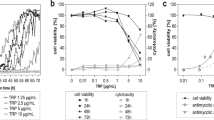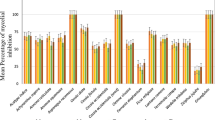Abstract
Antibiotics are being successfully used to fight many infectious diseases caused by pathogenic microorganisms. However, new infectious diseases are continuously being identified, and some known pathogens are becoming resistant against known antibiotics. Furthermore, many antifungals are causing serious side effects in long-term treatments of patients, and many skin infections caused by dermatophytes are difficult to cure. The beneficial roles of resident cutaneous microbiota to inhibit pathogenic microorganisms have been shown for many vertebrate species. Microbial symbionts on the amphibian skin for example can be a source of powerful antimicrobial metabolites that can protect amphibians against diseases, such as chytridiomycosis, caused by a fungal pathogen. In this research, we investigated whether cutaneous bacterial species isolated from Lithobates catesbeianus (North American bullfrog), an invasive amphibian species that is resistant to chytridiomycosis, produce secondary metabolites that can be used to inhibit the growth of three species of dermatophytes (Microsporum gypseum, Epidermophyton floccosum, and Trichophyton mentagrophytes) which are known to cause topical or subdermal skin infections in humans. Strongly anti-dermatophyte bacterial species that belonged to the Bacillaceae, Streptomycetaceae, Pseudomonadaceae, Xanthomonadaceae, Aeromonadaceae, and Enterobacteriaceae were identified. This research has provided evidence of the presence of cutaneous anti-dermatophyte bacteria from L. catesbeianus which might provide a basis for health care providers to experiment with new antifungals in the future.





Similar content being viewed by others
References
Georgopapadakou NH, Walsh TJ. Human mycoses: drugs and targets for emerging pathogens. Science. 1994;264:371–3.
Weitzman I, Summerbell RC. The dermatophytes. Clin Microbiol Rev. 1995;8:240–59.
Leyden JJ. Microbial ecology in interdigital “athlete’s foot” infection. Semin Dermatol. 1982;1:149–52.
Richardson MD. Changing patterns and trends in systemic fungal infections. J Antimicrob Chemother. 2005;56:5–11.
Pfaller MA, Pappas PG, Wingard JR. Invasive fungal pathogens: current epidemiological trends. Clin Infect Dis. 2006;43:3–14.
Dismukes WE. Introduction to antifungal drugs. Clin Infect Dis. 2000;30:653–7.
Johnson LB, Kauffman CA. Voriconazole: a new triazole antifungal agent. Clin Infect Dis. 2003;36:630–7.
Enoch DA, Ludlam H, Brown NM. Invasive fungal infections: a review of epidemiology and management options. J Med Microbiol. 2006;55:809–18.
Chang C-H, Yinong Y-X, Kurth T, Orav JE, Chan K. The safety of oral antifungal treatments for superficial dermatophytosis and onychomycosis: a meta-analysis. Am J Med. 2007;120:791–8.
Patsalos PN, Perucca E. Clinically important drug interactions in epilepsy: interactions between antiepileptic drugs and other drugs. Lancet Neurol. 2003;2:473–81.
Ghannoum MA, Rice LB. Antifungal agents: mode of action, mechanisms of resistance, and correlation of these mechanisms with bacterial resistance. Clin Microbiol Rev. 1999;12:501–17.
Huang DB, Ostrosky-Zeichner L, Wu JJ, Pang KR, Tyring SK. Therapy of common superficial fungal infections. Dermatol Ther. 2004;17:517–22.
Rollins-Smith LA, Carey C, Longcore J, Doersam JK, Boutte A, Bruzgal JE, Conlon JM. Activity of antimicrobial skin peptides from ranid frogs against Batrachochytrium dendrobatidis, the chytrid fungus associated with global amphibian declines. Dev Comp Immunol. 2002;26:471–9.
Rollins-Smith LA, Reinert LK, O’Leary CJ, Houston LE, Woodhams DC. Antimicrobial peptide defense in amphibian skin. Integr Comp Biol. 2005;45:137–42.
Jenssen H, Hamill P, Hancock REW. Peptide antimicrobial agents. Clin Microbiol Rev. 2006;19:491–511.
Ramsey JP, Mercurio A, Holland JA, Harris RN, Minbiole KP. The cutaneous bacterium Janthinobacterium lividum inhibits the growth of Trichophyton rubrum in vitro. Int J Dermatol. 2013. doi: 10.1111/ijd.12217.
Daszak P, Strieby A, Cunningham AA, Longcore JE, Brown CC, Porter D. Experimental evidence that the bullfrog (Rana catesbeiana) is a potential carrier of chytridiomycosis, an emerging fungal disease of amphibians. Herpetol J. 2004;14:201–7.
Garner TWJ, Perkins MW, Govindarajulu P, Seglie D, Walker S, Cunningham AA, Fisher MC. The emerging amphibian pathogen Batrachochytrium dendrobatidis globally infects introduced populations of the North American bullfrog, Rana catesbeiana. Biol Lett. 2006;2:455–9.
Ramsey JP, Reinert LK, Harper LK, Woodhams DC, Rollins-Smith LA. Immune defenses against Batrachochytrium dendrobatidis, a fungus linked to global amphibian declines, in the South African clawed frog, Xenopus laevis. Infect Immun. 2010;78:3981–91.
Gervasi SS, Urbina J, Hua J, Chestnut T, Relyea RA, Blaustein RA. Experimental evidence for American bullfrog (Lithobates catesbeianus) susceptibility to the chytrid fungus (Batrachochytrium dendrobatidis). EcoHealth. 2013;10:166–71.
Simmaco M, Mignogna G, Barra D. Antimicrobial peptides from amphibian skin: What do they tell us? Biopolymers. 1998;47:435–50.
Goraya J, Knoop FC, Conlon JM. Ranatuerins: antimicrobial peptides isolated form the skin of the American Bullfrog, Rana catesbeiana. Biochem Biophys Res Comm. 1998;250:589–92.
Ardipradja K, Alford RA, Marantelli G, Reinert LK, Rollins-Smith LA. Resistance to chytridiomycosis varies among amphibian species and is correlated with skin peptide defenses. Anim Conserv. 2005;10:409–508.
Els WJ, Henneberg R. Histological features and histochemistry of the mucous glands in ventral skin of the frog (Rana fuscigula). Histol Histophathol. 1990;5:343–8.
Duellman WE, Trueb L. Biology of amphibians. New York: McGraw-Hill; 1986.
Brizzi R, Delfino G, Pellegrini R. Specialized mucous glands and their possible adaptive role in the males of some species of Rana (Amphibia, Anura). J Morphol. 2002;254:328–41.
Austin RM. Cutaneous microbial flora and antibiosis in Plethodon ventralis. In: Bruce RC, Jaeger RG, Houck LD, editors. The biology of plethodontid salamanders. New York: Kluwer Academic/Plenum; 2000. p. 127–36.
Harris RN, James TY, Lauer A, Simon MA, Patel A. The amphibian pathogen Batrachochytrium dendrobatidis is inhibited by the cutaneous bacterial flora of amphibian species. EcoHealth. 2006;3:403–5.
Harris RN, Brucker RM, Walke JB, Becker MH, Schwantes CR, Flaherty DC, Lam BA, Woodhams DC, Briggs CJ, Vredenburg VT, Minbiole KPC. Skin microbes on frogs prevent morbidity and mortality caused by a lethal skin fungus. ISME J. 2009;3:818–24.
Lauer A, Simon MA, Banning JL, André E, Duncan K, Harris RN. Common cutaneous bacteria from the eastern red-backed salamander can inhibit pathogenic fungi. Copeia. 2007;3:630–40.
Lauer A, Simon MA, Banning JL, Lam BA, Harris RN. Diversity of cutaneous bacteria with antifungal activity isolated from female four-toed salamanders. ISME J. 2008;2:145–57.
Woodhams DC, Rollins-Smith LA, Alford RA, Simon MA, Harris RN. Innate immune defenses of amphibian skin: antimicrobial peptides and more. Anim Conserv. 2007;10:425–8.
Lam BA, Walke JB, Vredenburg VT, Harris RN. Proportion of individuals with anti-Batrachochytrium dendrobatidis skin bacteria is associated with population persistence in the frog Rana muscosa. Biol Conserv. 2010;143:529–31.
Daszak P, Berger L, Cunningham AA, Hyatt AD, Green DE, Speare R. Emerging infectious diseases and amphibian population declines. Emerg Infect Dis. 1999;5:735–48.
Chinchar VG, Bryan L, Silphadaung U, Noga E, Wade D, Rollins-Smith L. Inactivation of viruses infecting ectothermic animals by amphibian and piscine antimicrobial peptides. Virology. 2004;323:268–75.
Rölleke S, Muyzer G, Wawer C, Wanner G, Lubitzi W. Identification of bacteria in a biodegraded wall painting by denaturing gradient gel electrophoresis of PCR-amplified gene fragments coding for 16S rRNA. Appl Environ Microbiol. 1996;62:259–65.
Lane DJ, Pace B, Olsen GJ, Stahl DA, Sogint ML, Pace NR. Rapid determination of 16S ribosomal RNA sequences for phylogenetic analyses. Proc Natl Acad Sci USA. 1985;82:6955–9.
Lane DJ. 16S/23S rRNA sequencing. Nucleic acid techniques in bacterial systematics. In: Stackebrand E, Goodfellow M, editors. Nucleic acid techniques in bacterial systematics. New York: Wiley; 1991. p. 115–75.
Tamura K, Peterson D, Peterson N, Stecher G, Nei M, Kumar S. MEGA5. Molecular evolutionary genetics analysis using maximum likelihood, evolutionary distance, and maximum parsimony methods. Mol Biol Evol. 2011;28:2731–9.
Nei M, Kumar S. Molecular evolution and phylogenetics. New York: Oxford University Press; 2000.
Katz E, Demain AL. The peptide antibiotics of Bacillus: chemistry, biogenesis, and possible functions. Bacteriol Rev. 1977;41:449–74.
Silo-Suh LA, Lethbridge BJ, Raffel SJ, He H, Clardy J, Handelsman J. Biological activities of two fungistatic antibiotics produced by Bacillus cereus UW85. Appl Environ Microbiol. 1994;60:2023–330.
Stein T. Bacillus subtilis antibiotics: structures, syntheses and specific functions. Mol Microbiol. 2005;56:845–57.
Tagg JR, Dierksen KP. Bacterial replacement therapy: adapting ‘germ warfare’ to infection prevention. Trends Biotechnol. 2003;21:217–23.
Pimentel-Elardo S. Novel anti-infective secondary metabolites and biosynthetic gen clusters from Actinomycetes associated with marine sponges. PhD thesis. Julius-Maximilians-University Würzburg, Germany, School of Life Sciences, Section: Infection and Immunity; 2008.
Minkwitz A, Berg G. Comparison of antifungal activities and 16S ribosomal DNA sequences of clinical and environmental isolates of Stenotrophomonas maltophilia. J Clin Microbiol. 2001;39:139–45.
Naik PR, Raman G, Narayanan KB, Sakthivel N. Assessment of genetic and functional diversity of phosphate solubilizing fluorescent pseudomonads isolated from rhizospheric soil. Microb Ecol. 2008;56:492–504.
Bush K. Metallo-β-Lactamase: a class apart. Clin Infect Dis. 1998;27:48–53.
Vanneste JL, Yu J, Beer SV. Role of antibiotic production by Erwinia herbicola Eh252 in biological control of Erwinia amylovora. J Bacteriol. 1992;174:2785–96.
Wright SA, Zumoff CH, Schneider L, Beer SV. Pantoea agglomerans strain EH318 produces two antibiotics that inhibit Erwinia amylovora in vitro. Appl Environ Microbiol. 2001;67:284–92.
Rollins-Smith LA, Conlon MJ. Antimicrobial peptide defenses against chytridiomycosis, an emerging infectious disease of amphibian populations. Dev Comp Immunol. 2005;29:589–98.
Walke J, Becker MH, Loftus SC, House LL, Cormier G, Jensen RV, Belden LK. Amphibian skin may select for rare environmental microbes. ISME J. 2014;8:2207–17.
Culp CE, Falkinham JO III, Belden LK. Identification of the natural bacterial microflora on the skin of eastern newts, bullfrog tadpoles and redback salamanders. Herpetologia. 2007;63:66–71.
Kueneman JG, Wegener Parfrey L, Woodhams DC, Archer HM, Knight R, McKenzie VJ. The amphibian skin-associated microbiome across species, space and life history stages. Mol Ecol 2013. doi:10.1111/mec.12510.
Staley JT, Konopka A. Measurements of in situ activities of nonphotosynthetic microorganisms in aquatic and terrestrial habitats. Annu Rev Microbiol. 1985;39:321–46.
Acknowledgments
This project was supported by a ‘Student Research Scholarship’ from California State University Bakersfield which led to the completion of a Master’s Thesis. Thanks also to Professors C. Kloock and P. Smith from California State University Bakersfield for their critical comments and suggestions that helped to improve this manuscript.
Conflict of interest
The authors state no conflict of interest.
Author information
Authors and Affiliations
Corresponding author
Rights and permissions
About this article
Cite this article
Lauer, A., Hernandez, T. Cutaneous Bacterial Species from Lithobates catesbeianus can Inhibit Pathogenic Dermatophytes. Mycopathologia 179, 259–268 (2015). https://doi.org/10.1007/s11046-014-9838-1
Received:
Accepted:
Published:
Issue Date:
DOI: https://doi.org/10.1007/s11046-014-9838-1




